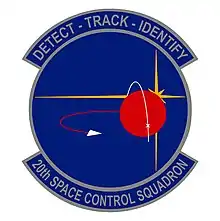20th Space Control Squadron
The 20th Space Control Squadron (20 SPCS) is a Space Delta 2 unit with the mission to execute multiplatform, tactical space warfighting domain characterization, recognition, and responsiveness to achieve 21st Space Wing and United States Strategic Command intent.
| 20th Space Control Squadron | |
|---|---|
 Squadron emblem | |
| Active | 1966 – present |
| Country | |
| Branch | |
| Type | Space operations |
| Role | Space surveillance |
| Size | 250 personnel |
| Part of | Space Delta 2 |
| Home base | Eglin AFB, Florida |
| Motto(s) | "Detect – Track – Identify" |
| Systems |
|
| Decorations | Air Force Outstanding Unit Award |
| Commanders | |
| Current commander | Lieutenant Colonel Alfred Maynard[1] |
History
Eglin Site C-6's squadron of the 9th Aerospace Defense Division activated in September 1968. and was turned over to Air Force Systems Command on 20 September 1968, and became operational in December 1968.
Eglin Site C-6 was assigned to Aerospace Defense Command on 20 December 1968. In 1972 20% of the site's "surveillance capability…became dedicated to search for SLBMs" and was subsequently renamed the 20th Missile Warning Squadron (the USAF SLBM Phased Array Radar System was initiated In November 1972 by the JCS while the Army's MSR and PAR phased arrays for missile defense were under construction.) The FPS-85 was expanded[specify] in 1974, and "a scanning program to detect" SLBM warheads was installed in 1975. Alaska's AN/FPS-108 Cobra Dane phased array site was completed in 1976 and from 1979 until 1983, Site C-6 was assigned to Strategic Air Command's Directorate of Space and Missile Warning Systems (SAC/SX)--as were the new PAVE PAWS phased array sites operational in 1980.
Space Command
In 1983 Eglin Site C-6 transferred to Space Command (later renamed Air Force Space Command), and the "FPS-85 assumed a deep space role in November 1988 after receiving a range-extension upgrade enabling integration of many pulses." With the addition of additional missile warning sites becoming active, the squadron eliminated its missile warning mission, and the surveillance squadron name was restored in 1987. The unit was renamed the 20th Space surveillance squadron when a "new radar control computer" was installed at the site in 1994. By 1998, the site was providing space surveillance on "38 percent of the near-earth catalogue" of space objects (ESC's "SND C2 SPO was the System Program Office.) "A complete modernization…of the 1960s signal-processing system was being studied in 1999", and in 2002 Site C-6 was tracking "over 95 percent of all earth satellites daily." The squadron was renamed the 20th Space Control Squadron in February 2003. By 2011 the site's "16 million observations of satellites per year" (rate of 30.4/minute) was "30 percent of the space surveillance network's total workload".
GEODSS
In 2016, the 20th Space Control Squadron acquired the three Ground-based Electro-Optical Deep Space Surveillance (GEODSS) sites. GEODSS is an optical system that uses telescopes, low-light level TV cameras, and computers. It replaced an older system of six 20 inch (half meter) Baker-Nunn cameras which used photographic film.
There are three operational GEODSS sites that fall under the 20th Space Control Squadron:
- Detachment 1 Socorro, New Mexico 33°49′02″N 106°39′36″W / 33.8172°N 106.6599°W / 33.8172; -106.6599
- Detachment 2 Diego Garcia, British Indian Ocean Territory 7°24′42″S 72°27′08″E / 7.41173°S 72.45222°E / -7.41173; 72.45222.
- Detachment 3 AMOS, Maui, Hawaii 20°42′32″N 156°15′28″W / 20.7088°N 156.2578°W / 20.7088; -156.2578
GEODSS tracks objects in deep space, or from about 3,000 mi (4,800 km) out to beyond geosynchronous altitudes. GEODSS requires nighttime and clear weather tracking because of the inherent limitations of an optical system. Each site has three telescopes. The telescopes have a 40-inch (1.02 m) aperture and a two-degree field of view. The telescopes are able to "see" objects 10,000 times dimmer than the human eye can detect. This sensitivity, and sky background during daytime that masks satellites reflected light, dictates that the system operate at night. As with any ground-based optical system, cloud cover and local weather conditions directly influence its effectiveness. GEODSS system can track objects as small as a basketball more than 20,000 miles (30,000 km) in space or a chair at 35,000 miles (56,000 km), and is a vital part of Space Command's Space Surveillance Network. Each GEODSS site tracks approximately 3,000 objects per night out of 9,900 object that are regularly tracked and accounted for. Objects crossing the International Space Station (ISS) orbit within 20 miles (32 km) will cause the ISS to adjust their orbit to avoid collision. The oldest object tracked is Object #5 (Vanguard 1) launched in 1958.[2]
List of commanders
- Lt Col Alfred Maynard, 16 July 2020[3]
Decorations
References
- https://www.peterson.spaceforce.mil/News/Article/2278920/20-spcs-welcomes-new-commander/
- "Vanguard Satellite, 1958". NASA. Retrieved 19 May 2020.
- https://www.peterson.spaceforce.mil/News/Article/2278920/20-spcs-welcomes-new-commander/
- AFSPC Special Order GA-10, 2001
- AFSPC Special Order GA-97, 2000
- AFSPC Special Order GA-62, 6 December 1999
- AFSPC Special Order GA-58, 6 December 1999
- AFSPC Special Order GA-09, 1 November 1997
- AFSPC Special Order GA-30, 1994
- AFSPC Special Order GA-95, 1992
- AFSPC Special Order GA-45, 1990

